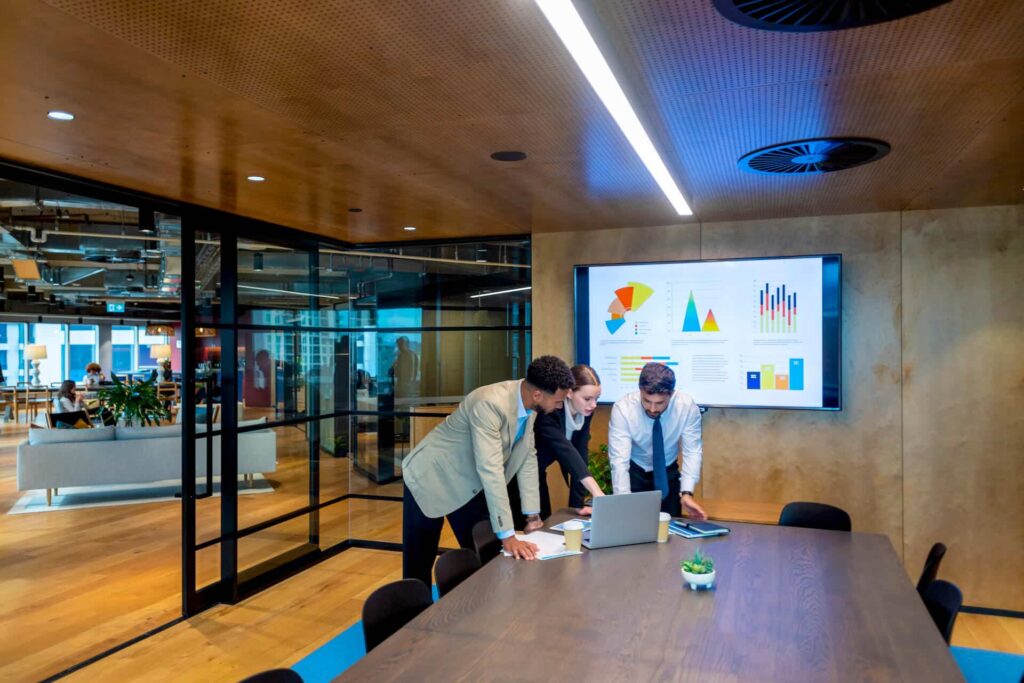Meetings are the lifeblood of collaboration, innovation, and strategic alignment. But in today’s fast-paced and far-reaching business environment, meetings have had to evolve to accommodate a variety of new dynamics. Remote and hybrid work models, modern office settings, and the prominence of digital communication have made casual routine gatherings around a box of doughnuts, coffee, and a simple projector a thing of the past.
These days, coordinating effective meetings requires planning, the right technology, and data-driven insights to ensure you are making the most of your team and your workspaces. And it all starts with the setting.
Conference rooms and other meeting spaces must be equipped with the right tools to facilitate productive meetings, and advanced technology is required to optimize these spaces and how organizations use them. That’s where conference room analytics comes in.
Conference room analytics go beyond simple room scheduling—they involve room utilization, engagement of meeting participants, technological efficiency, and more. By harnessing the power of data, organizations can improve meeting efficiency and productivity, ensuring that every team interaction is purposeful and conducive to achieving desired outcomes.
Conference and meeting room analytics can help streamline resource allocation, minimize scheduling conflicts, and create environments where collaboration thrives. This article will explore conference room analytics, including its benefits, practical applications, and future trends.
What is Conference Room Analytics?
Conference room analytics is an in-depth approach to understanding, optimizing, and managing your meeting spaces. It leverages advanced data collection, analysis, and visualization techniques to provide actionable insights into how meeting rooms are utilized, how resources are allocated, and how effectively meetings are conducted. Let’s look at some of the valuable metrics conference room analytics measures and tracks.
Room Utilization Metrics
Room utilization metrics encompass data related to how frequently meeting rooms are booked, the duration of each booking, and the actual utilization rates versus the available capacity. By analyzing these metrics, companies can identify underutilized spaces, optimize room layouts, and organize resources more efficiently.
Technological Efficiency
Conference room analytics measure the usage patterns of technological resources within meeting rooms, such as audiovisual equipment, collaboration tools, and connectivity solutions. Insights derived from this data can inform decisions related to equipment upgrades, maintenance schedules, and technology investments.
Attendee Engagement and Participation
By monitoring attendee punctuality, no-shows, participation rates, and engagement levels during meetings, conference room analytics can provide valuable insights into meeting effectiveness. Organizations can identify trends, patterns, and areas for improvement, thereby enhancing collaboration and decision-making processes.
Cost Optimization
Beyond operational efficiencies, conference room analytics enable organizations to optimize costs associated with meeting room maintenance, resources, technological infrastructure, and corporate real estate. By identifying areas of wastage or inefficiency, organizations can make informed decisions that align with budgetary constraints and financial objectives.

What Are the Benefits of Conference Room Analytics?
Applying advanced data analytics techniques to meeting and conference rooms provides businesses with a variety of benefits:
Data-Driven Decision Making
Using real-time data and analytics, organizations can make informed decisions related to workspace usage, office layouts, and scheduling processes. Making decisions backed by up-to-date information ensures that meeting spaces are utilized effectively, maximizing productivity and employee engagement.
Enhanced User Experience
Conference room analytics empower organizations to create tailored meeting experiences that cater to the unique needs and preferences of attendees, including in-person, remote, and hybrid employees. Whether it’s optimizing room layouts, upgrading technological tools, or implementing feedback mechanisms, businesses can create and use workspaces in a way that best benefits the work styles of their employees.
Strategic Workspace Planning
By analyzing trends, patterns, and utilization rates, conference room analytics inform strategic workspace planning initiatives. Organizations can adapt to evolving needs, reduce waste, and create work environments that facilitate innovation, collaboration, and growth.
Hardware and Software: What Tools Can Help Improve Your Conference Rooms?
Optimizing conference room functionality requires the right balance of innovative software and hardware solutions. Let’s explore some of the key tools that can elevate your conference room experience.
Software Solutions
- Room Booking Software. Comprehensive cloud-based room booking software solutions streamline the reservation process, provide real-time availability updates, and offer seamless integration with organizational calendars and other scheduling platforms. Features such as user-friendly interfaces, mobile accessibility, and customization options enhance user experience, avoid double bookings, and promote efficient room scheduling.
- Analytics Platforms. Advanced analytics software solutions like OfficeSpace Software offer invaluable insights into room utilization rates, meeting attendance, technological efficiencies, and meeting dynamics. By leveraging these meeting data sets, organizations can make informed decisions about how to set up their offices and meeting rooms for success.
- Collaboration Tools. Integrated collaboration platforms enable features such as document sharing, real-time editing, virtual whiteboarding, and communication channels, creating interactive and engaging meetings.
Hardware Solutions
- Interactive Displays. Interactive displays can facilitate seamless presentations, brainstorming sessions, and collaborative discussions. These displays, equipped with touch-screen capabilities, intuitive interfaces, and connectivity options, enhance engagement, encourage participation, and streamline content sharing for hybrid teams.
- Video Conferencing Systems. As remote and hybrid work models become more prominent and virtual collaboration becomes more commonplace, capable video conferencing systems are essential. High-definition cameras, microphone arrays, and accompanying software solutions enable organizations to host virtual meetings on Zoom or Google Meet, connect with remote teams, and effectively bridge geographical divides.
- Audio Solutions. Advanced audio solutions, including ceiling microphones, speaker systems, and noise-cancellation technologies, minimize distractions, improve clarity, and create immersive meeting experiences where work gets done.
- Room Booking Systems. Room booking systems rely on more than just software. Digital room booking displays, occupancy sensors, and intuitive scheduling platforms facilitate efficient room utilization, reduce scheduling conflicts, and improve user accessibility. When integrated with software solutions, these hardware components allow you to make the most of each workspace in your office.
The Future of Work: Using AI in Conference Room Analytics
As the work landscape continues to evolve, driven by technological advancements, shifting work models, and new user expectations, the integration of Artificial Intelligence (AI) in conference room analytics is set to play a transformative part in how we approach workplace intelligence.
AI-powered analytics not only enhance the capabilities of traditional conference room management systems but also pave the way for unprecedented insights, efficiencies, and innovations. Here are some of the ways AI is transforming how businesses approach data and analysis:
- Predictive Analytics. AI algorithms can analyze historical data, patterns, and trends to forecast room utilization rates, scheduling conflicts, and resource requirements. By leveraging machine learning techniques, organizations can proactively address challenges before they cause issues.
- Automation. AI-powered analytics platforms like OfficeSpace Software can automate data collection, analysis, and visualization processes, providing companies with real-time insights and actionable recommendations and driving organizational efficiency.
- IoT Integration. AI algorithms integrate with Internet of Things (IoT) devices, sensors, and smart technologies to collect real-time data, monitor room conditions, and optimize occupancy rates.
Best Practices for Setting Up a Conference Room
Navigating the complexities of modern workspace management and collaboration can be challenging. By setting up conference rooms that cater to diverse needs and facilitate effective communication, you can provide your teams with the tools needed to innovate and adapt to the future of work.
While every workplace is unique and will require different solutions depending on how they are configured, there are a few general best practices for setting up meeting rooms that can help achieve optimal functionality, user satisfaction, and organizational success.
Define Clear Objectives and Requirements
Conduct a thorough needs assessment to identify specific requirements, user preferences, and organizational goals. Consider factors such as room capacity, technological capabilities, accessibility, and functionality to align the conference room setup with organizational needs and objectives.
Support User Experience and Accessibility
Focus on user experience by creating a comfortable, accessible, and inclusive environment that caters to diverse needs, preferences, and requirements. Consider factors such as room layout, seating arrangements, acoustics, lighting, and ergonomics to enhance employee satisfaction and promote effective communication.
Invest in Quality Solutions
Research and invest in state-of-the-art hardware and software solutions that can provide the data and functionality you need. Consider factors such as interactive displays, video conferencing systems, audio solutions, room booking platforms, and analytics tools to create a cohesive, integrated, and functional conference room ecosystem.
Prioritize Security and Compliance
When collecting and analyzing data, it is important to implement strong security measures, protocols, and compliance frameworks to protect sensitive information, ensure user privacy, and maintain organizational integrity. Consider factors such as data encryption, access controls, authentication mechanisms, and regulatory compliance to safeguard private information.
Embrace Flexibility and Scalability
As the future of work continues to change, it is critical to maintain flexibility and scalability by designing conference rooms that can adapt to your workforce’s evolving needs. Modular furniture, configurable layouts, expandable infrastructure, and interoperable systems can help future-proof conference room setups and support organizational growth.
Encourage Collaboration and Innovation
Create a collaborative, interactive, and innovative environment that encourages creativity, engagement, and teamwork. By providing the right tools, interactive technologies, brainstorming spaces, and design elements, you can support effective knowledge-sharing and problem-solving within your organization.
The Future of Meeting Rooms
Setting up conference rooms that align with organizational objectives, user needs, and technological advancements requires careful planning and strategic investment. By relying on conference room analytics, employing best practices, embracing innovation, and prioritizing user experience, organizations can create a work environment that will thrive in today’s dynamic and interconnected business landscape.
As businesses continue to evolve and adapt to new work models, the conference room remains a cornerstone of collaboration and innovation, and meeting room analytics is the best way to make data-driven decisions about these important workspaces.




